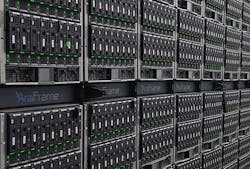How Data Center Management Solutions Drive Sustainability and Help Ensure a Climate-Secure World
Reducing greenhouse gas emissions in line with climate science is good for the planet as well as the companies that the data center industry serves. Science-based targets show companies just how much and how quickly they need to reduce their greenhouse gas emissions to prevent the worst effects of climate change. In this way, businesses, data centers and hyperscale facilities alike can begin to take concrete steps to future-proof an increasingly digital economy with measurable and lasting commitments to sustainability.
The world’s largest data centers can contain many tens of thousands of IT devices requiring multi-megawatts of power capacity, and, in some facilities, drawing upwards of more than 100 MW. As a recent Uptime Institute survey reports, “The global growth of data center capacity has led to higher scrutiny of resource use by customers, pressure groups, media and, more recently, policymakers.”
Electricity is the single largest operational facility cost, so it comes as no surprise that larger data centers closely monitor infrastructure power consumption rates and usage effectiveness. According to the Uptime survey, more than four in five data center owner-operators surveyed track power consumption. Seventy percent track power usage effectiveness (PUE). Troubling, however—especially for an industry that is taking up the mantle of environmental stewardship with renewed vigor in light of corporate sustainability mandates and governmental policies—only 40 percent of data center providers track server utilization, and just over one-third measure data center or IT carbon emissions.
Waste Not, Want Not
Ever since the landmark, but ultimately misleading, U.S. Environmental Protection Agency (EPA) Report to Congress on Server and Data Center Energy Efficiency was published fifteen years ago, improving PUE and reducing carbon emissions has been inching up the to-do list of every data center manager, competing with uptime and reliability as the major factors driving the market.
Even China, historically, not a poster child for environmentalism, last summer published an aggressive three-year-plan for its data center sector, requiring that new facilities achieve a PUE of 1.3 and a utilization of 60 percent by the end of 2023.
PUE is a measure of a facility’s total power delivered divided by its IT equipment power usage. Hence, a PUE rating of 1.0 would be equivalent to a 100 percent efficient facility. Total facility power is measured as the power dedicated to operating an entire data center. IT equipment power is defined as the power required to operate devices used to manage, route, store, or process data within a data center.
Data center management solutions provide accurate, real-time power, thermal and health monitoring and management for individual servers, group of servers, racks and IT equipment in the data center, offering capabilities that are useful for both IT and facility administrators seeking to increase energy efficiency and uptime, and improve sustainability. On average, approximately 40 percent of a data center’s consumed power is spent on cooling while roughly 50 percent can be traced back to servers and network devices. With advanced data center management solutions, servers become wireless sensors, alerting staff when temperature and power extremes occur, and providing device-level power and thermal data, eliminating the need for hardware sensors altogether.
With such granular device-level power and thermal data, IT staff can analyze cooling conditions in the data center, enabling them to raise the temperature by as much as 5°C, while continually monitoring devices to correct potential thermal issues such as hotspots in real time. This results in reduced cooling costs and improved PUE, thus increasing energy efficiency and sustainability. Lacking this thermal data, IT managers will maintain lower temperatures in the data center, wasting precious energy resources to maintain safe cooling margins beyond the necessary levels.
For Data Centers, the Environment Is Now Mission-Critical
In large data centers, the lack of sufficient workload performance monitoring typically leads IT administrators to purchase more hardware. By deploying a data center management solution, operators are able to quickly detect and analyze underutilized systems by monitoring their CPU utilization and power consumption over time. This function enabled IT staff at a cybersecurity provider to identify hundreds of servers that were underutilized across three of its data centers, and remotely shut down systems that were not needed or End-of-Lifed.
In large data centers, however, IT managers often find it difficult to retrieve server utilization data since they lack permission to access the operating system. But by extracting utilization data from server’s BMC (Baseboard Management Controller), data center management solutions can offer a way to monitor server utilization without OS level access. Sometimes referred to as out-of-band management (OOBM), IT staff can use this functionality to access real time CPU, memory, and IO utilization data, and easily identify underutilized servers. The ability to monitor actual power consumption and power consumption trends by the hour, day, week, etc., is especially valuable to high-growth, high-capacity data center customers with unpredictable usage and growth models.
The data center industry, which gave wings and provided thrust to the digital transformation of business and society during a time of tumultuous change, has another urgent, mission-critical responsibility—to our environment. However, the path of sustainability that leads to net zero for data center providers, whether that target date is 2030, 2040, or 2050, is not a journey to be made in a sprint, it is a marathon. On this path, every useful tool, every breakthrough technology, and every innovative solution, including data center management solutions, should be employed to help us reach our destination of a climate-secure world.
Eric Xie is Software Application Engineer for Intel Data Center Management Solutions. Intel Data Center Manager (Intel DCM) is a software solution that collects and analyzes the real-time health, power, and thermals of a variety of devices in data centers helping you improve the efficiency and uptime.





